
Image by sebastian del val via Pixabay.
Natron and Ritual Purity
Natron is a naturally occurring mixture of salts found in dried up salt lake beds. The ancient Egyptians had a variety of uses for natron, which included the mummification process, making ceramics, combined with oil it was used as an early form of soap and it was also used in ritual purification. In pagan practice today, we use home-made natron to establish a state of w’ab that is, a state of cleanliness and ritual purity. In this week’s post, we’ll look at how to make and use natron in modern Kemetic practice, along with some practical advice on ritual purity.
First, let’s clear up some common misconceptions about ritual purity, as our concept of purity has become somewhat stigmatised in modern times. You don’t need the track record of a saint to achieve ritual purity! Think of ritual purity as spiritual hygiene. Let’s use the analogy of a nurse washing their hands before they touch their patient, which we call hand hygiene.
Why do you suppose a nurse washes their hands? Is it because there’s something deeply, fundamentally wrong with the nurse as a human being, and they need to wash all their imperfections away, or is it because of what might be on their hands that’s a cause for concern? It’s the same issue with ritual purity. It’s not you or your past deeds that are the problem, it’s the fact that life is messy and just as we live in a mishmash of microbes, we also live in a mishmash of energy. Some of those energies we want to bring along to the ritual and some of them we don’t, hence why we perform ritual purification. Natron is one of the best sacred substances we can use to achieve that.
When we perform ritual purification, it extends beyond ourselves to include the space we are working in, as well as the tools we use in ritual. We can’t see microbes without the aid of a microscope, yet we know the world is crawling with them. Likewise, we can’t see negative energies without the aid of clairvoyance or psychic vision but unfortunately, the world is crawling with negative energies, and it’s not a pretty picture. If we don’t do anything to break the chain of infection, we can get sick. COVID-19 has taught the public a lot about the need for hygiene, personal protective equipment (PPE) and maintaining boundaries. These concepts can be transposed to the psychic realm and applied to modern Kemetic practice, as well as other forms of neo-paganism. In decades past, we called these practices cleansing and psychic protection and it really is that simple!
Hieroglyphs for w’ab from hieroglyphs.net
In your own approach to ritual purity, it may help to remember that performing ritual purity is a ritual in itself. The action of performing ritual purity, along with your spoken words and intention is an act of heka, or sacred magic. This is your divine spiritual birthright, not only as a Kemetic practitioner but as a human being, so use heka wisely! I’ll talk more about magic in an upcoming post but for now, just remember that you are a conductor of heka. The more you are aware of it, the more you nurture it and respect it, the stronger of a conductor you will become.
I hope all of the above helps to dispel some of the now obsolete, puritanical programming we’ve inherited over many generations. The netjeru or ancient Egyptian deities are very likely to already know who you are, even when you reach out to them for the very first time, because they have already been reaching out to you. They can see your light and shadow; they already know you’re a package deal and they still want to work with you, anyway!
While it’s a good idea to uphold Ma’at or ethical conduct as best you can, don’t think you can’t approach the gods if you are somehow less than perfect. That way of thinking was not part of the ancient Egyptian worldview, however w’ab and Ma’at were and so we continue these traditions today because they are positive and purposeful.
Alright, let’s make our Natron!
This is an easy, simplified version of natron using salt (sodium chloride) and baking soda (sodium bicarbonate). While quite basic — pardon the pun — it is still an effective cleanser both physically and spiritually. It’s also very affordable, as you can see. The only tool you may not have, which requires an investment, is a mortar and pestle, which I highly recommend. A good mortar and pestle will last you a lifetime. I’ve had mine for nearly 20 years now and it holds a lot of fond memories. Owning two would be ideal; one for food grade work, and one for non-food grade work and resinous gums (more on that later). In the future, I’ll post a slightly more complex version of natron and maybe a video as well!
Step One
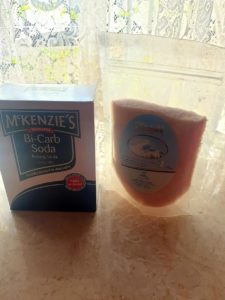
Combine equal parts of baking soda and salt. In this batch, I am using pink Himalayan salt but you can use sea salt or plain table salt if you wish.
Step Two
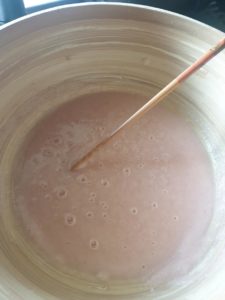
Add filtered water, just enough water to make a slightly watery paste and stir.
Step Three
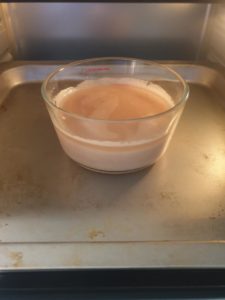
Transfer to an oven safe dish and bake at around 170 degrees Celsius or 350 degrees Fahrenheit until all the water has evaporated. If you added too much water, like I did in the example, it will take a bit longer to bake but don’t stress, it will evaporate! Baking times will depend on the size of your batch.
Step Four
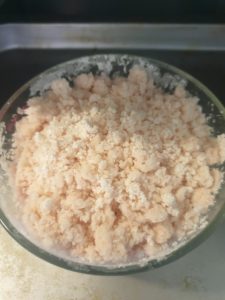
Here’s what your rough natron will look like after baking: it will be hard, stony and crunchy. Carefully scoop this out with a strong spoon into a mortar and pestle.
Step Five
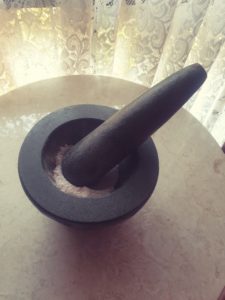
Pound the rough natron back into a powder using a mortar and pestle. It works best if you add small amounts at a time (2 tbsp or so) and work along the sides of the bowl (or mortar) using a downward pounding motion with the pestle. Use your non-dominant hand to steady the mortar, while your dominant hand does the grinding. Try to avoid any stirring motion as this will be ineffective and cause unnecessary strain to your wrists.
Step Six
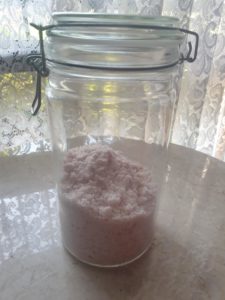
Store your natron in an airtight jar and it’s now ready for ritual use.
Some additional thoughts on natron
Perhaps I’m overly sentimental, but after I made my first batch of natron, I formed an emotional attachment to it and couldn’t part with it! This also applies to every subsequent batch; yes, I’m a hoarder of natron. If you’re less sappy than I am, you can add a pinch of it per cup of water and use it in ritual purification. Simply pour over your hands as you prepare for ritual. You can also add a 1/2 cup to a ritual bath. Misting bottles are another option. Asperging or scattering your natron-water around is yet another way to achieve ritual purity of your sacred space.
Personally, I find that keeping my natron in a jar near my altar works quite well and when I burn candles or diffuse essential oils around it, this is enough to activate the natron. I can feel a ‘tug’ or ‘pull’ when I hold my hands over it, indicating that it’s actively absorbing and transmuting negative energy, which is exactly what we want our natron to do. If it can work sitting inside a jar, why then waste it and wash it down the drain? This is my own independent, intuitive perspective. If you are a newbie, in time you will develop your own perspectives and ways of doing things, which is totally fine. To each their own!
Thank you, for reading Kemetic Blog. Enjoy crafting your natron. I’d love seeing your pictures and reading your stories about how you go!
𓆸
© Scott Rose / Kemetic Blog – All Rights Reserved.
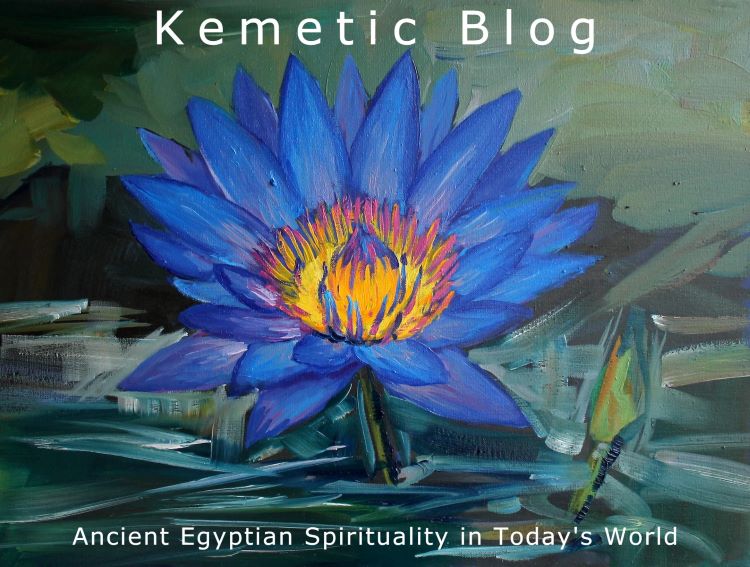
No Comments